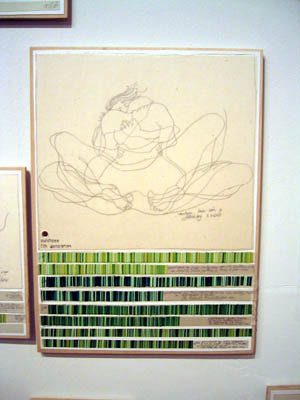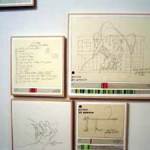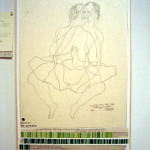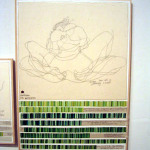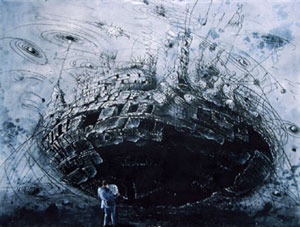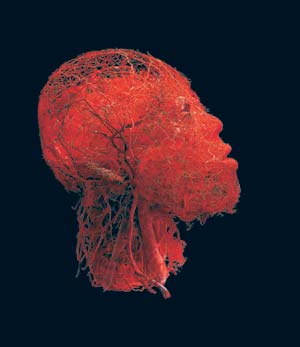It is impossible to ignore. Sex decorates the room...many moods of sex, many kinds of sex, many days of sex. Sex is contained into entrancing small and medium scale drawings, mounted to wood and arranged almost amorphously. From the intricacy and subtlety of line, to the obsessive, invested logic of the project, the show seduces us into “Integrating Sex into Everyday Life” – or at least representations of sex, and at least into the part of daily life that finds us in the gallery space. As the collage like diary unfolds slowly across the four walls of the main room at Allston Skirt, it carries us from a seductive formal field to the implied expanse of daily minutia. It is this daily minutia to which Phelps, echoing the battle cry of Russian formalist critic Victor Shklovsy, draws our attention. If the artist had a job, for Shklovsky, it was to force us to take notice, there, where we might have forgotten.
The installation declares its terms immediately: it requires time, patience, and a willingness to laugh at the little things. To rush in and out is to miss it completely. From the small diary like fragments and daily lists, to the larger contour drawings that bring sex onto center stage, we are asked to take notice, not of our own lives as much as the life of an artist, under a (self-edited) microscope. Disclosure, as such, then, is key. Not only does this particular body of work document sex during the year after Ms. Phelps ‘came out,’ but it documents the shopping that she did, the notes that she left, the train rides she took, and the bills that she paid. We move from formal intricacy, visual seduction and contour erotica, to the inescapable financial transactions that delimit the everyday.
These financial transactions appear on two registers: First, every list itemizes money spent and money earned. We see the daily economy of a young artist in New York, the anatomy of her financial life punctuating her romantic saga. That was then. Now, here, in Boston, another financial register emerges. You might begin, as you survey this pin-up board of a beautifully drawn life, to notice that many of the pieces are punctured and stamped: “Purchase Second Generation,” “Purchase Tenth Generation.” Then you might notice that the sumptuous bands of color, in red, green and grey, extending below the frames of many of the drawings, not only look like ‘bar codes,’ but each one sports small scribbles detailing the names of purchasers and purchase amounts. And slowly you might realize that what you thought was an installation detailing the daily life of an artist (or, for all we might know without prior knowledge, her fictional counterpart), is, in large part a performance in which you are being asked to step onto center stage. You are invited, even tempted, to participate in an art world round robin, as the artist editions out copies of moments in her life for a fee—sometimes as small as $40.
Let me describe the process. First the drawings are hung, usually mounted, in the gallery space. The purchaser of any of these drawings buys the “first generation.” Before the owner of this “first generation” departs with her piece, the artist traces a copy, mounts this copy and punctures a hole in it, beside which is now stamped “second generation.” Below the piece, a rectangular band of grey paper is then glued, sporting the number of green lines corresponding to the number of dollars paid, the name of the purchaser, and the amount of purchase. And on we go. The “oldest” piece I noticed was on its eleventh generation, but some seemed set to top even that, after this show. We are left with an odd fantasy of voyeurism, coupled with a hint of exhibitionism, if you pay and play. With a subtle twist, the viewer is left contemplating the purchase and exchange of the proper name and the private moment. Ms Phelps work, which anatomizes the everyday, asks us to participate in an economic exchange where what is being bought and sold is not only an aesthetic field but a moment in time. The one she re-remembers every time she makes a copy-- and that includes every time she makes a copy of the one with your name on it and passes it along.
"Integrating Sex Into Daily Life" is on view at Allston Skirt (February 7 – 28, 2004). Her work can also be seen in “Self-Evidence: Identity in Contemporary Art” at the DeCordova Museum and Sculpture Park in Lincoln (February 7 - May 30, 2004), and “Danica Phelps: Walking from LA to San Francisco” at the Judi Rotenberg Gallery (February 5 – 28, 2004) on Newbury Street.
- Installation View: Danica Phelps, Integrating Sex into Everyday Life.
- Danica Phelps, 2/10/03, #146 (4th Generation), pencil, ink and watercolor on paper mounted on wood.
- Danica Phelps, Making love with D. January 6, 2003 (5th Generation), pencil, ink and watercolor on paper mounted on wood.
Image courtesy of the artist & Allston Skirt Gallery, Boston.
Allston Skirt
Judi Rotenberg
Decordova Museum
LFL Gallery
Natalie Loveless is a performance/installation artist, displaced Montrealer and PhD candidate in the History of Consciousness department of the University of California, Santa Cruz. She is a founding contributor of Big RED & Shiny.

